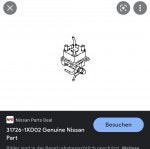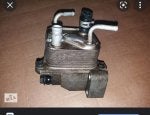Hello, I urgently need an answer.
Now, does the Nissan Murano 2006 CVT 4WD 3.5 V6 have an in-transmission filter or not? I found ancient forum posts that say Nissan doesn't have a part number for it but there is a filter anyway. When I search on the websites of suppliers for spare parts, I also find a set.
At least I got a part number for the oil pan gasket from Nissan. The filter is the external part that sits in front of the gearbox when you take the wheel off and look at it. Should the part also be cleaned and can it be cleaned? Or does that not affect it? I don't want to swap everything that doesn't need to be swapped. According to the internet, if there are problems with the gearbox, it may be due to a filter, but one of the ones in the gearbox. I also find comparison numbers, but Nissan dealers can't do anything with them. Presumably a Nissan dealer never disassembled a transmission but simply replaced it back then because of the warranty. So before I unscrew the oil pan, I would like to order a filter as a replacement just to be on the safe side, but I don't know if there really is one or not. Always considering that it is the European version of the Nissan Murano, left-hand drive. Anyone have clear information?
Thanks very much , sorry for my bad english i have to use the Google Translator, best regards from Germany.
![Image]()
![Image]()
![Image]()
![Image]()
![Image]()
![]()
![]()
![]()
![]()
![]()
![]()
uj
![]()
![]()
Now, does the Nissan Murano 2006 CVT 4WD 3.5 V6 have an in-transmission filter or not? I found ancient forum posts that say Nissan doesn't have a part number for it but there is a filter anyway. When I search on the websites of suppliers for spare parts, I also find a set.
At least I got a part number for the oil pan gasket from Nissan. The filter is the external part that sits in front of the gearbox when you take the wheel off and look at it. Should the part also be cleaned and can it be cleaned? Or does that not affect it? I don't want to swap everything that doesn't need to be swapped. According to the internet, if there are problems with the gearbox, it may be due to a filter, but one of the ones in the gearbox. I also find comparison numbers, but Nissan dealers can't do anything with them. Presumably a Nissan dealer never disassembled a transmission but simply replaced it back then because of the warranty. So before I unscrew the oil pan, I would like to order a filter as a replacement just to be on the safe side, but I don't know if there really is one or not. Always considering that it is the European version of the Nissan Murano, left-hand drive. Anyone have clear information?
Thanks very much , sorry for my bad english i have to use the Google Translator, best regards from Germany.













